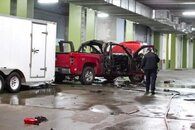- Messages
- 1,860
- Reaction score
- 102
Please keep this A&I thread as a way for all of us to learn and prevent another catastrophe.
Let's examine the possibilities of what could have happened and prevention:
1-gear failure? valve damage or handle jarred during loading?
2-truck failure? It's been mentioned David had ongoing problems with systems in the truck. I personally don't belive this caused the fire but may have contributed.
3-dive knowledge? I personally find this doubtful in this case, as those who know him, know he was consciousnesses about training, and learning as much as he could about any subject.
4-diver error? Possibly, fatigue, rushing, multi-tasking.What we need to ask ourselves is: "Are we diligent about handling any and all cylinders each time we transport them?" I know when I'm tired or in a hurry, I'm less careful, less observant and I can become complacent in my methods when I'm loading/unloading my 20th tank of the day. I am thinking carefully how I transport gear especially deco cylinders in my SUV...
With the reports of an explosion, could the burst disk have been plugged our doubled. I'm not trying to point fingers or start anything but on other threads we've discussed the pros/cons of doubling or even plugging burst disc. I know this is a fairly common practice for a lot of cave and tech divers.




